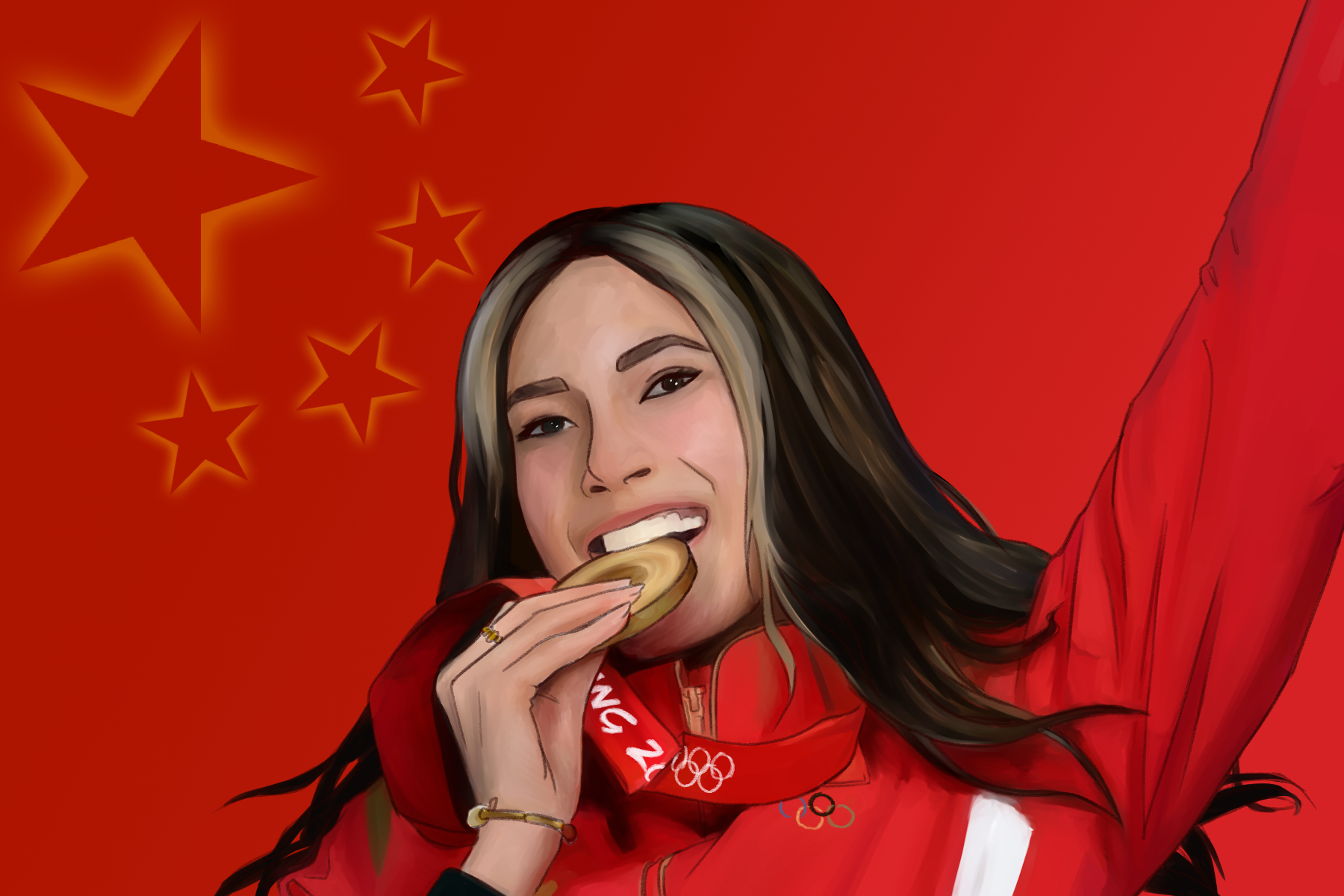When you think about it, identity is such a personal little tool that can change how a person acts, and reacts, to everyday circumstances. It touches everything — from work and social life to the way one behaves around friends and family, the expression of identity seems to tip the scale of how we read others. Just seeing someone express their identity is a powerful thing that comes in all shapes and forms. Whether one’s identity stems from a cultural connection or leans more toward their ethnicity, the individual that rises out from these sources will be a product of everything that brought them here today.
But what happens when those personal definitions end up impacting your career in a negative way or hindering your social life? These issues of defining oneself are difficult to grapple with when multiple ethnic backgrounds come into play. Combine that with a public stage, such as something like the Olympics, and you have the recipe for a quick downfall or a surprising champion. Luckily, all these factors are just in a day’s work of being Eileen Gu, the teenage superstar of the 2022 Winter Olympics.
So, who’s this fresh face that’s sweeping up snowy success? Eileen Gu is an 18-year-old freestyle skier from San Francisco, California. At an early age, Gu’s mother introduced her to skiing on a whim, and her knack for the sport quickly grew. She was an instant hit from the start of her career, seizing the spotlight during her Winter X Games debut early in 2021. Swiftly walking away with two gold medals and a bronze — at the ripe age of 17 — Gu established herself as an athlete to keep an eye on.
With her debut at the Olympics on the horizon as well, an eager audience awaited to see what Gu would deliver. In the recent 2022 Winter Olympics in Beijing, she competed in the freestyle skiing categories ranging from big air and slopestyle to the halfpipe. Her breathtaking wins at the games spurred on her success both on the slopes and off. American-born Gu gave her all to the sport, and swept up a whopping two gold medals and a silver for China. But how did she do it?
To the surprise of many, Gu’s sunny California upbringing contrasts greatly with her current career success. Born to a Chinese mother and an American father (not in the picture), the athlete stands out from her peers because she is firmly both Chinese and American in all her pursuits. The contrast of Gu’s upbringing in the States, to learning Mandarin and constantly traveling to China with her mother, exemplifies how she’s straddled her dual heritage.
It’s safe to say that on a surprisingly public level, the young skier is loud and proud about her mixed-ethnic background. So much so that she switched her country affiliation prior to the 2022 Winter Olympics in Beijing. Back in an Instagram post from 2019, Gu announced that she would be competing for China in 2022: “The opportunity to help inspire millions of young people where my mom was born, during the 2022 Beijing Olympic Winter Games is a once-in-a-lifetime opportunity to help to promote the sport I love.” After a childhood of bouncing between cultures, the choice to represent the country that her mother is from is a mature one on Gu’s part. From the fan’s perspective, the decision seems out of the blue, but her life-long journey as a biracial athlete paved the way to take this leap.
The careful consideration for this change did not happen overnight, even if the backlash did. Gu’s decision to switch which country she represented came with high risk and a slew of internet criticism. For one, after years spent training in the U.S., many critics accused her of disregarding the opportunities that her American upbringing gave to her. However, the narrative that Gu chose China over the U.S. shrouds Gu’s story in opinions far removed from the truth of her goals.
At face value, the largest tensions from Gu’s China affiliation related back to citizenship. Though her heritage is tied strongly to China, the question of representing the country on paper proved crucial to her performance in the 2022 Winter Olympics in Beijing. Since China doesn’t allow for dual citizenship, American-born Gu would have to relinquish U.S. citizenship to compete. After she gracefully made her way to the Winter Olympics and immediately scooped up three medals for China, the internet grew curious about whether Gu held Chinese citizenship now.
However, figuring out exactly what rules were applied and bent to get her there was even more of a mystery: Dodging questions about her citizenship status became a part of Gu’s routine at the games. While these questions are not something she has to answer, the audience watching — and criticizing — Gu continued to be baffled by her nationality. Although it sparked publicity buzz, her decision to switch nationalities for the games is not uncommon. Olympians such as Gus Kenworthy and Zhu Yi are among a list of athletes who chose to switch the countries that they represent, within Olympic guidelines. Whether it’s due to a matter of getting on a team, or for personal reasons, it is possible to switch which country one represents without shifting the game grounds.
So, if switching affiliations isn’t such a large issue in the Olympic games, what makes Gu’s story such a hot topic in such a cold sport? AP News noted that she had “amassed an army of cynics” against her medals for China, and a good portion of the backlash stemmed from those who are unfamiliar with her mission to be of “both” countries. As Gu has touted time and time again, embracing a biracial heritage prompts her to represent both American upbringings and cultural ties to China as well. On a social media level, Gu’s connections with her China-based audience, while maintaining her American-ness, occupied this sweet middle ground between the two teams.
Despite these intentions, the reality of straddling both American and Chinese identity at the highly publicized 2022 Winter Olympics became more difficult in practice. While Gu tirelessly refrains from commenting on the political engagements between both of her “home” countries, she is careful to dance around questions that could frame her as favoring one view over the other. The stress of presenting this dual persona as her public image, while facing the opinionated repercussions that result, added pressure to Gu’s already-controversial decision.
Gu’s image leading up to the Olympics was also crucial in driving home her status of being from “both” American and Chinese cultural backgrounds. Off the slopes, Gu is known for her ever-growing modeling career. Bringing together skiing and strutting came naturally to her, and the teenage star soon fronted multiple campaigns for both countries leading up to the Winter Olympics. As the poster child for big-name companies such as Vogue and Louis Vuitton, as well as advertising for Chinese TV and even milk cartons, Gu expanded her territorial reach to publications from every part of her background. The skier carved a space for herself in each drastically different cultural context, as a face that will hopefully bridge the gap between the two.
A Wall Street Journal video remarked on her overall message of unity that makes her a stand-out star: “There’s no one else like her who’s as dominant in her sport, who’s truly multinational and who has one foot squarely in two countries.” Whether she’s working toward that goal during competitions or continuing to model for both U.S. and Chinese publications, Gu holds firm in her identity even when she is engulfed by criticism.
While Gu’s entire Olympic debut is undoubtedly “a controversial decision that thrust her firmly into the spotlight,” the positive outcomes shed light on the reality of mixed-ethnic identities among individuals. Her position as an Asian American athlete with a strong sense of self allowed her to seek out and represent two cultures, with little favoritism toward one side or the other. Though her choice to represent China does reveal that her medals go to Team China, Gu holds firm that this does not discredit her American background and involvement with skiing. To showcase her multifaceted identity on the Winter Olympics stage plays up her initial decision, in a way that highlights the “mixed-ethnic” reality of it all.
Even though an individual person of a mixed ethnic and mixed cultural background is nothing new, it’s that question of “either-or” broadcasted on a public platform that makes Gu an exciting athlete to watch. Rather than lean into one facet of her identity, she cautiously enters the playing field as both. CNN reflected on Gu’s confidence in her identity as she explained, “When I’m in China, I’m Chinese. When I’m in the US, I’m American.” The luxury of code-switching between American and Chinese backgrounds — with a positive reception in each category — is a benefit only experienced by a few. However, what Gu provides is a new-age exemplar that can uphold their mixed ethnicity, without compromising their career or achievements. She is able to use it as an advantage that propels her to the front of the conversation, and to the top of the medal podium as well.
One cannot suppress the fact that even if Gu’s biracial persona helped build her image in the world of sports and beyond, “she had great access to both worlds.” There’s no doubt that she used an abundance of resources to make her pipe dream come true, yet Gu honors the privilege of her position through her sportsmanship. She brought her A-game performance under the pressure of her opportunity, which turned her into an inspiration to many. When Gu dominated the slopes as an American-born athlete representing China, she reaffirmed that it is possible for mixed-ethnic individuals to be fully themselves in their fields. It grants a larger, more realistic possibility of normalizing mixed backgrounds as part of the identity conversation, instead of a categorization that requires one to “pick” a side.
As for Gu, her bold Winter Olympics debut carved a name for herself both alongside and beyond the likes of Olympians who continued to spread that Asian American excellence. Even when fan favorites like Chloe Kim and Nathen Chen are held close to hearts and homes in the U.S., Gu found another home beyond the 50 states. Her fans from China are excited to watch her grow in their eyes as well, comfortably referring to Gu by her Chinese name, Ailing. In addition, this international fanbase also nicknamed their ski star their “Snow Princess,” showing affection to their cool new idol.
Back at her American home, Gu continues to hop and skip the lines between these shards of self, which wholly make her “Eileen Gu.” Even if her constant skirting around “the politics” of it all can’t be avoided forever, Gu sent a larger message with her risk-taking presence and highly skilled performance. And for the mixed-ethnicity person in the audience, watching Gu speak English and flaunting China’s flag on screen, maybe that picture is enough for now.


















This post brilliantly captures the complexities of Eileen Gu’s identity and the challenges she faces. It’s fascinating to see how her journey reflects broader conversations about cultural identity and authenticity in sports. The controversies surrounding her choices definitely add layers to her story, making it even more engaging. Thanks for sharing such a thoughtful analysis!